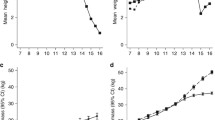Abstract
During puberty fat-free mass (FFM) and fat mass (FM) change quickly and these changes are influenced by sex and obesity. Since it is not completely known how these changes affect resting metabolic rate (RMR), the aim of the present study was to investigate the effect of body composition, age, sex and pubertal development of postabsorptive RMR in 9.5- to 16.5-year-old obese and non-obese children. Postabsorptive RMR was measured in a sample of 371 pre- and postpubertal children comprising 193 males (116 non-obese and 77 obese) and 178 females (119 non-obese and 59 obese). RMR was assessed by indirect calorimetry using a ventilated hood system for 45 min after an overnight fast. Body composition (FFM and FM) was estimated from skinfold measurements. The mean (± SD) RMR was significantly (P < 0.001) lower in non-obese (males: 5600 ± 972 kJ/24h; females: 5112 ± 632 kJ/24h) than in obese (males: 7223 ± 1220 kJ/24h; females: 6665 ± 1106 kJ/24h) children. This difference became non-significant when RMR was adjusted for body composition (FFM + FM). However, the difference between the genders still remained significant (control male: 6118 ± 507, control female: 5652 ± 507, P < 0.001; obese male: 6256 ± 507, obese female: 5818 ± 507 kJ/24h, P < 0.001). The main determinant of RMR was FFM. In the whole cohort, FFM explained 79.8% of the variation in RMR, followed by age, gender and FM adding further 3.8%, 1.1% and 0.8% to the predictability of RMR, respectively. No significant contribution for study group (obese, non-obese), pubertal stage, or fat distribution was found in the regression for RMR. The adjusted value of RMR (for FFM and FM) slightly, but significantly (P < 0.01) decreased between the age of 10–16 years, demonstrating the important effect of age on RMR.
Conclusions The resting metabolic rate of obese and control children is not different when adjusted for body composition. The main determinant of RMR is the fat-free mass, however, age, gender and fat mass are also significant factors. Pubertal development and fat distribution do not influence RMR independently from the changes in body composition.
Similar content being viewed by others

Author information
Authors and Affiliations
Additional information
Received: 4 March 1996 / Accepted: 21 August 1996
Rights and permissions
About this article
Cite this article
Molnár, D., Schutz, Y. The effect of obesity, age, puberty and gender on resting metabolic rate in children and adolescents. Eur J Pediatr 156, 376–381 (1997). https://doi.org/10.1007/s004310050618
Issue Date:
DOI: https://doi.org/10.1007/s004310050618



